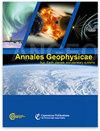保贤山(36.2°N, 128.9°E) OI 557.7 nm气辉全天候相机观测的中间层重力波传播特征
IF 1.9
4区 地球科学
Q3 ASTRONOMY & ASTROPHYSICS
引用次数: 1
摘要
摘要我们分析了2017-2019年在保贤山天文台(36.2°N, 128.9°E)观测到的全天空相机图像。图像数据是用一个以557.7 nm为中心的窄带滤波器获得的,用于在~ 96 km高度的OI气辉发射。在144个晴朗夜晚的图像中,共识别出150个波浪事件。识别波的波长、相速和周期的四分位数范围分别为20.5 ~ 35.5 km、27.4 ~ 45.0 m s−1和10.8 ~ 13.7 min,中位数分别为27.8 km、36.3 m s−1和11.7 min。夏季偏东北和春季偏北的传播方向可以解释为低层大气盛行风的过滤作用。在冬季,由于缓慢向北的背景风或高层大气中产生的二次波的无效过滤作用,可能观测到西北偏西的次优势波。利用几乎同时放置的流星雷达同时观测到的风数据,还推导出了波的固有相位速度和周期。每个季节对垂直繁殖的性质进行了评价。大多数观测到的波被发现是自由传播的,因此可以归因于低层或高层大气中的波源。本文章由计算机程序翻译,如有差异,请以英文原文为准。
Propagating characteristics of mesospheric gravity waves observed by an OI 557.7 nm airglow all-sky camera at Mt. Bohyun (36.2° N, 128.9° E)
Abstract. We analysed all-sky camera images observed at Mt. Bohyun observatory (36.2∘ N, 128.9∘ E) for the period 2017–2019. The image
data were acquired with a narrowband filter centred at 557.7 nm for the OI airglow emission at ∼ 96 km altitude. A total of
150 wave events were identified in the images of 144 clear nights. The interquartile ranges of wavelength, phase speed and periods of the
identified waves are 20.5–35.5 km, 27.4–45.0 m s−1 and 10.8–13.7 min with the median values of 27.8 km,
36.3 m s−1 and 11.7 min, respectively. The summer and spring bias of propagation directions of north-eastward and northward,
respectively, can be interpreted as the effect of filtering by the prevailing winds in the lower atmosphere. In winter the subdominant
north-westward waves may be observed due to a nullified filtering effect by slow northward background wind or secondary waves generated in the upper
atmosphere. Intrinsic phase speeds and periods of the waves were also derived by using the wind data simultaneously observed by a nearly co-located
meteor radar. The nature of vertical propagation was evaluated in each season. The majority of observed waves are found to be freely propagating
and thus can be attributed to wave sources in the lower or upper atmosphere.
求助全文
通过发布文献求助,成功后即可免费获取论文全文。
去求助
来源期刊

Annales Geophysicae
地学-地球科学综合
CiteScore
4.30
自引率
0.00%
发文量
42
审稿时长
2 months
期刊介绍:
Annales Geophysicae (ANGEO) is a not-for-profit international multi- and inter-disciplinary scientific open-access journal in the field of solar–terrestrial and planetary sciences. ANGEO publishes original articles and short communications (letters) on research of the Sun–Earth system, including the science of space weather, solar–terrestrial plasma physics, the Earth''s ionosphere and atmosphere, the magnetosphere, and the study of planets and planetary systems, the interaction between the different spheres of a planet, and the interaction across the planetary system. Topics range from space weathering, planetary magnetic field, and planetary interior and surface dynamics to the formation and evolution of planetary systems.
 求助内容:
求助内容: 应助结果提醒方式:
应助结果提醒方式:


